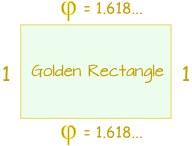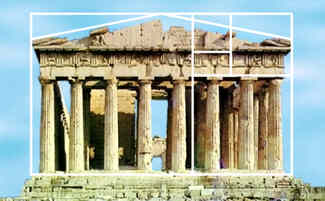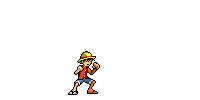 |
This rectangle has been made using the Golden Ratio, Looks like a typical frame for a painting, doesn't it? Some artists and architects believe the Golden Ratio makes the most pleasing and beautiful shape. |
| Many buildings and artworks have the Golden Ratio in them, such as the Parthenon in Greece, but it is not really known if it was designed that way. |
 |
The Actual Value
The Golden Ratio is equal to:
1.61803398874989484820... (etc.)
The digits just keep on going, with no pattern. In fact the Golden Ratio is known to be an Irrational Number, and I will tell you more about it later.Calculating It
You can calculate it yourself by starting with any number and following these steps:- A) divide 1 by your number (=1/number)
- B) add 1
- C) that is your new number, start again at A
| Number | 1/Number | Add 1 |
|---|---|---|
| 2 | 1/2=0.5 | 0.5+1=1.5 |
| 1.5 | 1/1.5 = 0.666... | 0.666... + 1 = 1.666... |
| 1.666... | 1/1.666... = 0.6 | 0.6 + 1 = 1.6 |
| 1.6 | 1/1.6 = 0.625 | 0.625 + 1 = 1.625 |
| 1.625 | 1/1.625 = 0.6154... | 0.6154... + 1 = 1.6154... |
| 1.6154... |
But it takes a long time to get even close, however there are better ways and it can be calculated to thousands of decimal places quite quickly.
Drawing It
Here is one way to draw a rectangle with the Golden Ratio:
|
 |
The Formula
Looking at the rectangle we just drew, you can see that there is a simple formula for it. If one side is 1, the other side will be:Fibonacci Sequence
There is a special relationship between the Golden Ratio and the Fibonacci Sequence:
0, 1, 1, 2, 3, 5, 8, 13, 21, 34, ...
(The next number is found by adding up the two numbers before it.)
And here is a surprise: if you take any two successive (one after the other) Fibonacci Numbers, their ratio is very close to the Golden Ratio. In fact, the bigger the pair of Fibonacci Numbers, the closer the approximation. Let us try a few:
A
|
B
|
B/A | |
|---|---|---|---|
2
|
3
|
1.5 | |
3
|
5
|
1.666666666... | |
5
|
8
|
1.6 | |
8
|
13
|
1.625 | |
...
|
...
|
... | |
144
|
233
|
1.618055556... | |
233
|
377
|
1.618025751... | |
...
|
...
|
... |
A
|
B
|
B / A
|
|
|---|---|---|---|
192
|
16
|
0.08333333... | |
16
|
208
|
13 | |
208
|
224
|
1.07692308... | |
224
|
432
|
1.92857143... | |
...
|
...
|
... | |
7408
|
11984
|
1.61771058... | |
11984
|
19392
|
1.61815754... | |
...
|
...
|
... |
The Most Irrational ...
I believe the Golden Ratio is the most irrational number. Here is why ...| One of the special properties of the Golden Ratio is that it can be defined in terms of itself, like this: | |
| (In numbers: 1.61803... = 1 + 1/1.61803...) | |
| That can be expanded into this fraction that goes on for ever (called a "continued fraction"): | |
 |
|
So, it neatly slips in between simple fractions.
Whereas many other irrational numbers are reasonably close to
rational numbers (for example Pi = 3.141592654... is pretty close to
22/7 = 3.1428571...)







0 komentar:
Posting Komentar